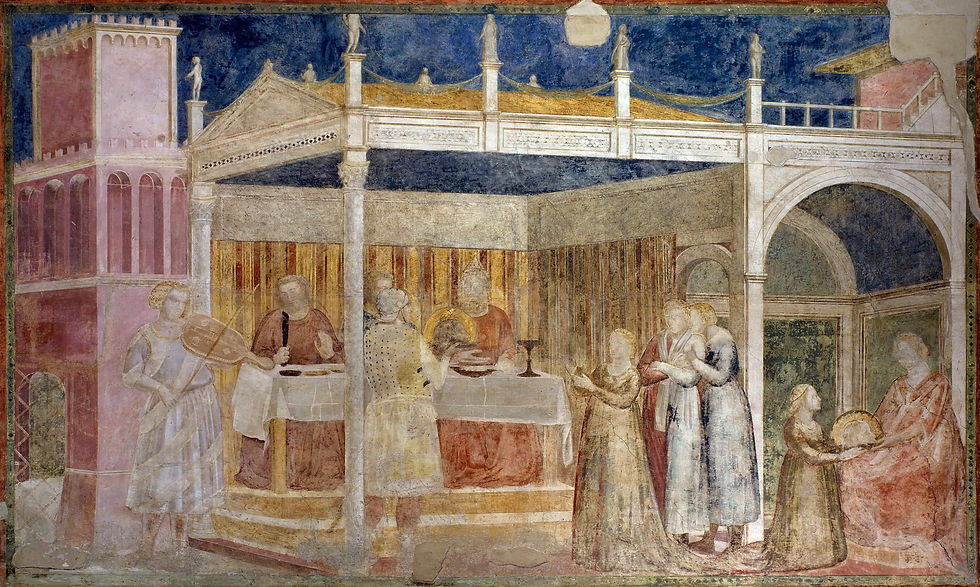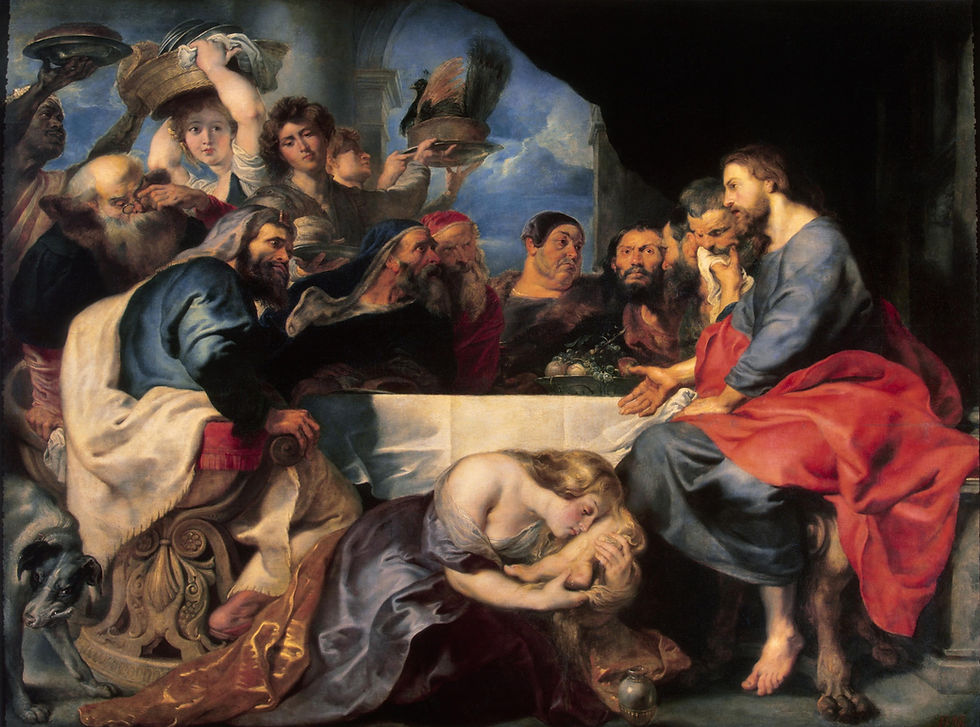Marriage at Cana | Feast of Herod | Meal at Simon the Pharisee | Allegories and Parables | Last Supper | Supper at Emmaus | Harvest of the Earth | Redemption
Feast in the House of Simon the Pharisee: the parable of the two debtors
.jpg)
FEAST IN THE HOUSE OF SIMON THE PHARISEE
Peter Paul Rubens (1588-1640), Anthony van Dyck (1599-1641)
Between 1618 and 1620
Hermitage, Saint Petersburg, Russia
During a feast hosted by Simon the Pharisee, where Christ and his disciples are guests, a repentant woman enters the house. She washes Jesus’ feet with her tears, dries them with her hair and anoints them with perfume. Simon is scandalised and criticises Christ for allowing a sinner to touch him and wasting the precious pomades. Jesus answers with the example of two debtors: one owing a lot, and the other a little. The lender writes off both their debts. Which debtor will love him more? The one who receives the most back, Simon replies. Jesus congratulates him for this answer.
Jesus reminds Simon of the woman’s show of respect and love towards him, then concludes that her many sins have been forgiven. He adds that anyone receiving a lesser pardon would feel less love. Then he addresses the sinner, announcing her forgiveness. Before the scandalised guests, he tells the woman that her faith has saved her and sends her off in peace.
"Rubens conceives the painting as a dramatic conflict between the Pharisees and Christ. The Pharisees' world of material values and religious dogmatism is opposed to the Christian world of sublime ideas and noble acts, a world of sympathy, charity and goodness. Certain of the justice and morality of his position, Christ, and his disciples as they take in the words of their teacher, stand against the Pharisees, on whose faces we can read lack of comprehension, annoyance and even anger. The conflict between two totally opposed approaches to life is emphasised by the structure of the painting and the arrangement of the colour, at the basis of which lies the principle of dynamic contrast: the left side of the composition, occupied by Simon the Pharisee, is full of swirling movement and is marked by the uneven rhythm of small, broken forms; the right side, dominated by the figure of Christ, is composed of calm lines and large areas of colour." (source : Hermitage Museum)

FEAST IN THE HOUSE OF SIMON THE PHARISEE (detail) Giovanni da Milano Fresco, 1635 - Rinuccini Chapel, Santa Croce, Florence, Italy

CHRIST IN THE SIMON HOUSE OF SIMON Dirk Bouts, 1460/70? Original, Gemäldegalerie, Berlin. Copy, St John's Hospital, Bruges, Belgium

MAGDALENE WASHING THE FEET OF CHRIST Master of the Legend of the Magdalene, ca. 1510/20 - Szepmuveszeti Muzeum, Budapest, Hungary
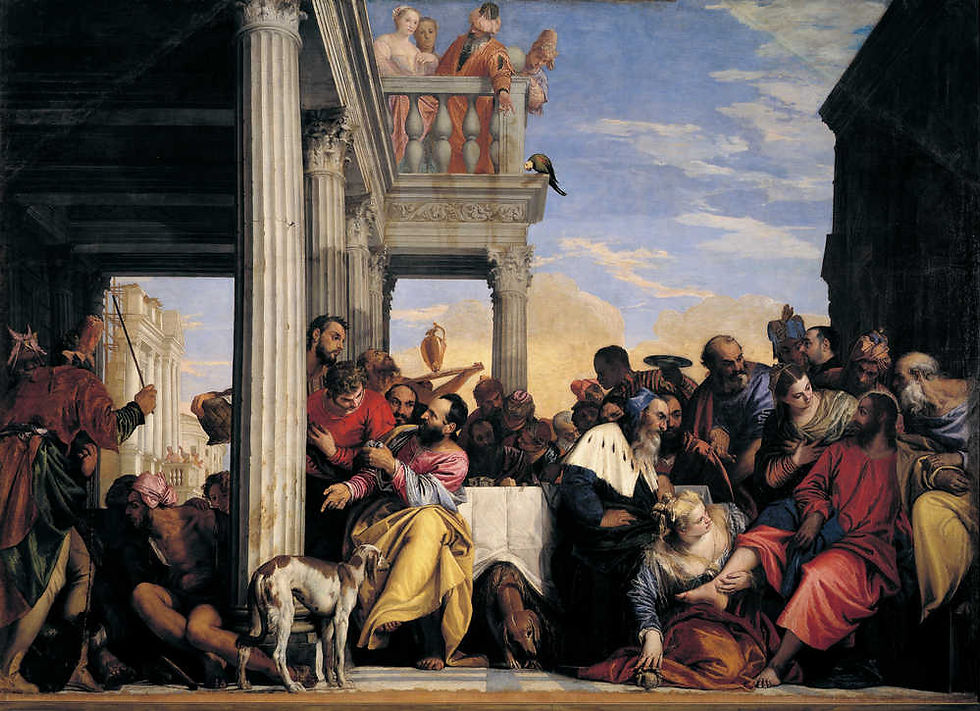
FEAST IN THE HOUSE OF SIMON Paolo Veronese, ca. 1560 - Galleria Sabauda, Turin
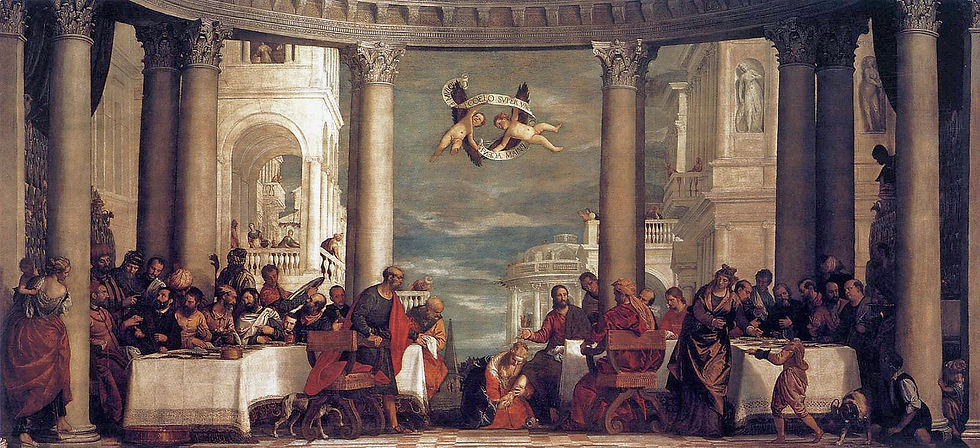
THE MEAL AT THE HOUSE OF SIMON Paolo Veronese Between 1570 and 1573 - Musée National du Château, Versailles
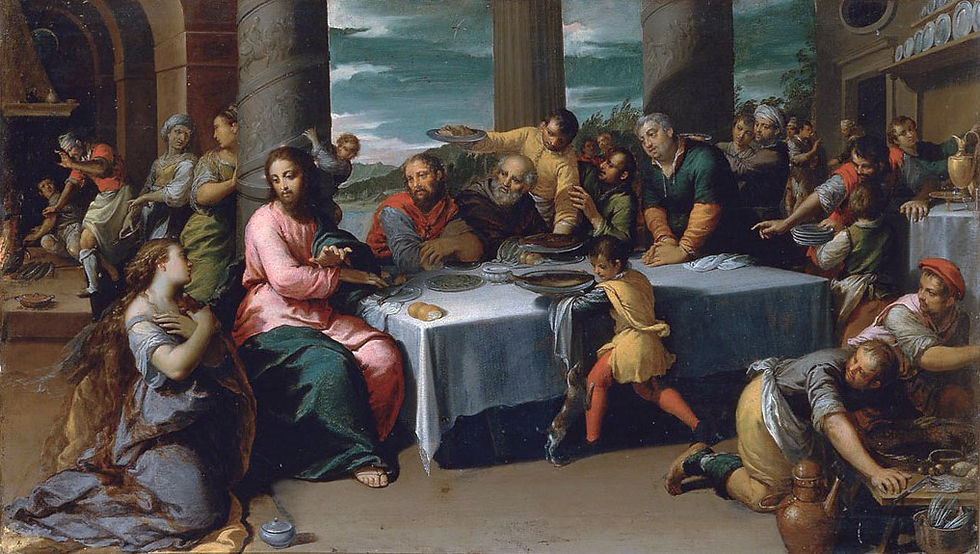
SUPPER IN THE HOUSE OF SIMON THE PHARISEE Scarsella Ippolito detto Scarsellino, ca. 1590 - Galleria Borghese, Rome

CHRIST IN THE HOUSE OF SIMON THE PHARISEE Artus Wolfaerts, ca. 1615/30? - Private collection
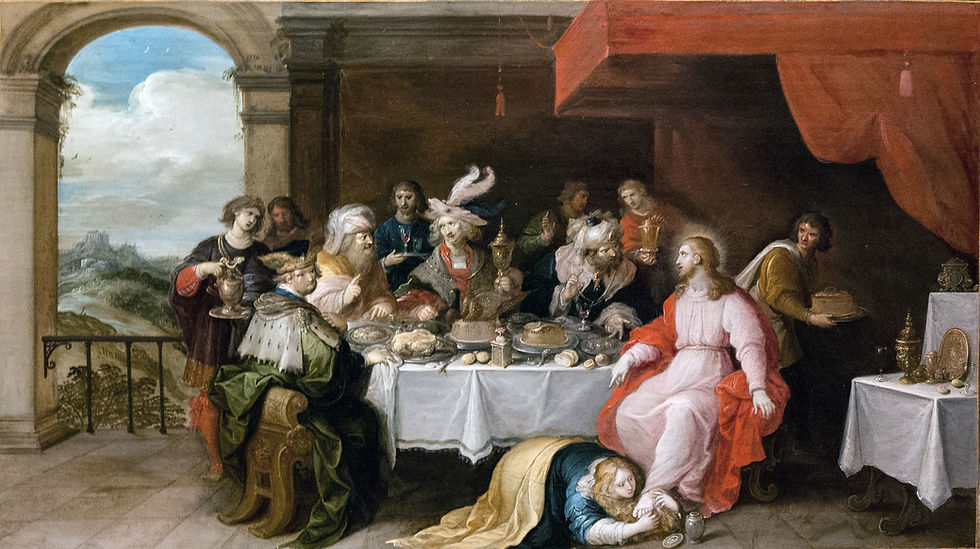
THE MEAL AT SIMON'S HOUSE Frans Franken II the Younger, 1637 - Fine Arts Museum, Rennes, France
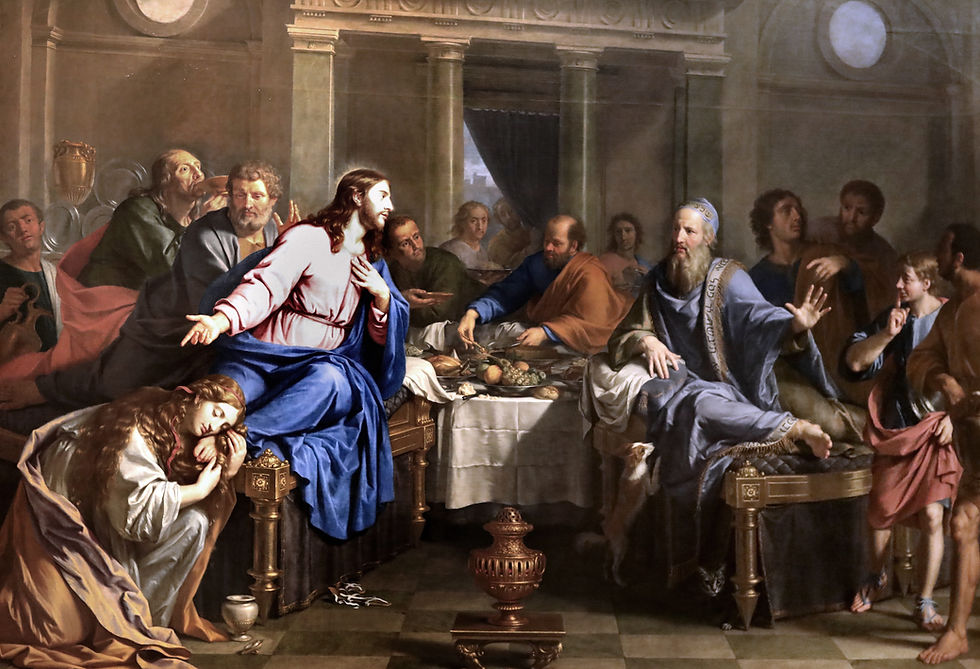
THE MEAL AT SIMON Philippe de Champaigne, ca. 1656 - Art Museum, Nantes, France
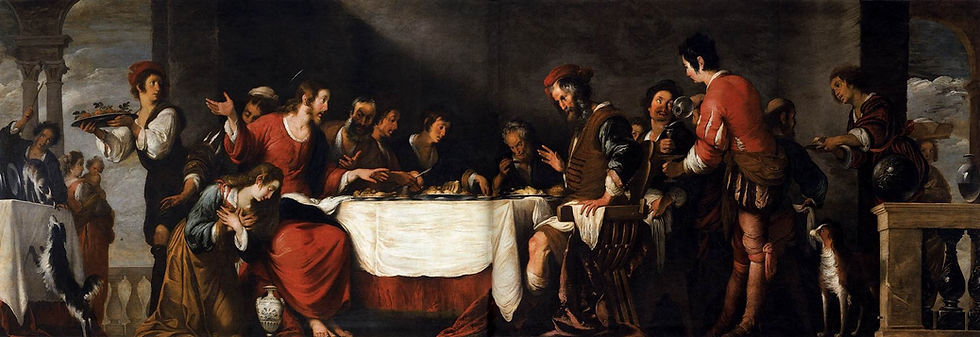
BANQUET AT THE HOUSE OF SIMON Bernardo Strozzi, ca. 1630 - Gallerie dell'Accademia, Venice
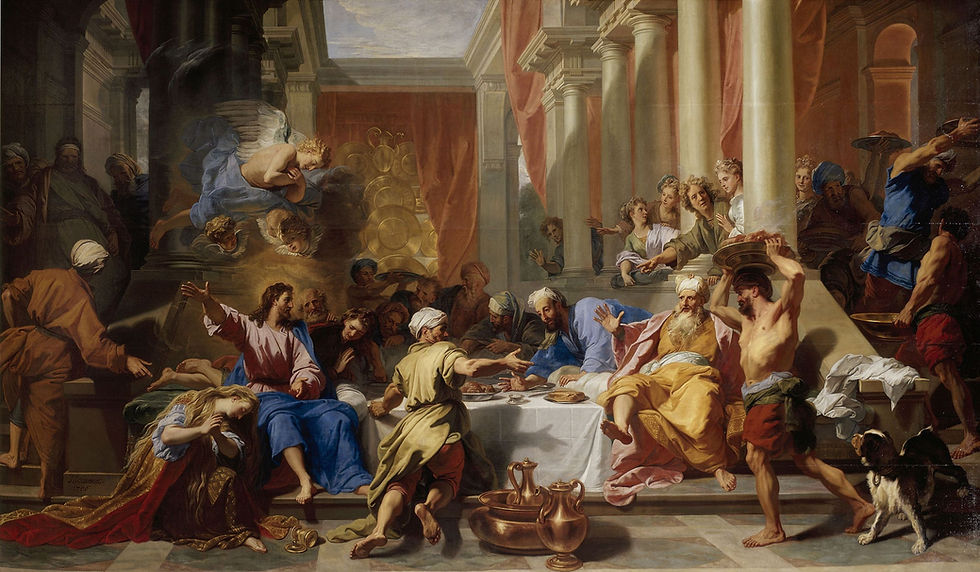
THE MEAL IN THE HOUSE OF SIMON Jean-Baptiste Jouvenet, ca. 1706 - Fine Arts Museum, Lyon, France

THE FEAST IN THE HOUSE OF SIMON Pierre Subleyras, 1737 - Musée du Louvre, Paris
> Click on the icons for a closer look at the artworks
Bible text: New Testament, Luke VII, 36-50
"And one of the Pharisees desired him that he would eat with him. And he went into the Pharisee's house, and sat down to meat. And, behold, a woman in the city, which was a sinner, when she knew that Jesus sat at meat in the Pharisee's house, brought an alabaster box of ointment, And stood at his feet behind him weeping, and began to wash his feet with tears, and did wipe them with the hairs of her head, and kissed his feet, and anointed them with the ointment. Now when the Pharisee which had bidden him saw it, he spake within himself, saying, This man, if he were a prophet, would have known who and what manner of woman this is that toucheth him: for she is a sinner. And Jesus answering said unto him, Simon, I have somewhat to say unto thee. And he saith, Master, say on. There was a certain creditor which had two debtors: the one owed five hundred pence, and the other fifty. And when they had nothing to pay, he frankly forgave them both. Tell me therefore, which of them will love him most? Simon answered and said, I suppose that he, to whom he forgave most. And he said unto him, Thou hast rightly judged. And he turned to the woman, and said unto Simon, Seest thou this woman? I entered into thine house, thou gavest me no water for my feet: but she hath washed my feet with tears, and wiped them with the hairs of her head. Thou gavest me no kiss: but this woman since the time I came in hath not ceased to kiss my feet. My head with oil thou didst not anoint: but this woman hath anointed my feet with ointment. Wherefore I say unto thee, Her sins, which are many, are forgiven; for she loved much: but to whom little is forgiven, the same loveth little. And he said unto her, Thy sins are forgiven. And they that sat at meat with him began to say within themselves, Who is this that forgiveth sins also? And he said to the woman, Thy faith hath saved thee; go in peace."
WHAT'S GOING ON?
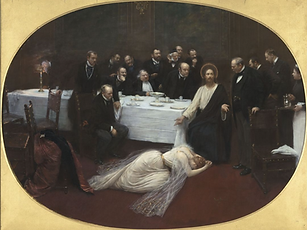.png)
This scene of The Magdalen at the House of the Pharisees (Jean Béraud, 1891 - Musée d'Orsay, Paris)* is set in a bourgeois interior. Renan (at the centre of the table, a serviette around his neck) is shown presiding over a fashionable dinner party of Parisian personalities. The chemist Eugene Chevreul (who had died the previous year, aged 103) is shown with glasses and greying whiskers; Alexandre Dumas junior is leaning on the back of a chair. Christ is also at this dinner party; his features were immediately identified as those of the journalist and militant socialist Albert Duc-Quercy (1856-1934). At his feet kneels a repentant Magdalen: she is none other than the famous demi-mondaine Liane de Pougy, who, repentant in real life, would end her days in a convent.
This painting, which caused a scandal before being bought by the Daily Telegraph’s Paris correspondent, Sir Campbell Clark, doesn’t lend itself easily to interpretation. Everything in it is ambiguous. It mixes religious ideal and social or moral satire. Its Christ is certainly on the side of the humble, but with the face of a tireless propagandist and strike leader!
Renan is at the centre of the scene; although an old adversary of the Church, he had become the official reference for governments concerned with order and stability. Renan had spoken of his “fear of seeming like a Pharisee”… yet here he is, embodying Simon the Pharisee! Octave Mirabeau qualified Jean Béraud as “Christophage [consumer of Christ] in Salons and clubs, willing to accommodate the son of God as fashion dictated”. Mere facetiousness, or an affirmation that even a modern, positivist society still needed the teachings of Christ and his faith in humanity? (Chantal Georgel, La pensée modern face au catholicisme, Histoire par l’image [online, in French: http://histoire-image.org/fr/etudes/pensee-moderne-face-catholicisme, consulted 18 May 2022].
* The anonymous sinner at the feast of Simon the Pharisee has often been identified as Mary Magdalen. Considered a model of penitence, Mary Magdalen was one of the Counter-Reformation’s favourite figures. At a time when the much-maligned Catholic Church was trying to reconquer areas which had been won over to the Protestant cause, she illustrated the power of religious feeling.
GALLERIES THE BLOOD OF CHRIST IN THE NEW TESTAMENT AND CHRISTIAN ICONOGRAPHY
> Wine and Painting > From Divine to Sacred > The Blood of Christ in the New Testament and Christian Iconography > Meal at Simon the Pharisee



